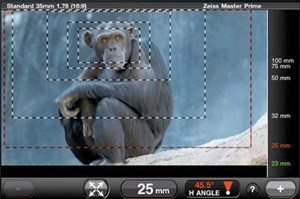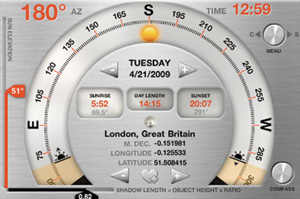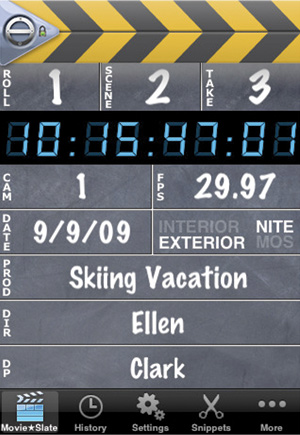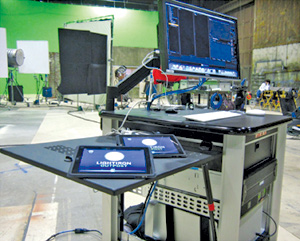BY DANIEL FRANKEL



 CREATIVE SOLUTIONS: Applications like
CREATIVE SOLUTIONS: Applications like
(top to bottom) Artemis, Helios, MovieSlate,
and Outpost are giving filmmakers more
digital options to help make better decisions. "I don't print out scripts anymore, I read them off my iPad," insists Richard Loncraine. In fact, the veteran British director says that if he had his way, his set would be entirely paperless, with all documents distributed via mobile devices. "With all the scripts, notes, call sheets and other information being passed around on a set, it might be cheaper just to give everyone an iPhone or iPad," he says.
"I tell my crew, if it doesn't come to me digitally, it doesn't exist," concurs director Steven Quale, who recently began shooting Final Destination 5. "If it's paper, I'll just lose it. In fact, I don't carry around binders of script notes anymore. I just carry around my iPad."
In fact, with the enormous number of personnel on film, TV or commercial shoots now using the iPhone, and the iPad presence growing, mobile software applications (aka "apps") that target the filmmaker market are rapidly expanding.
"We're seeing only the tip of the iceberg in terms of what can be done with computer interfaces on the set floor," says Loncraine.
For example, Artemis, a director's viewfinder app from fledgling Los Angeles developer Chemical Wedding, allows a director to see on their iPhone or iPad precisely what view they'll get from a specific lens (based on an extensive lens database) from any given shooting angle.
Not only can zoom dynamics be simulated with this app ($30 at Apple's iTunes store), but the director can get screen grabs—replete with shot data, including GPS coordinates—that can be saved and shared with, say, the DP. A note can
be included that would read, essentially, "We'll put the camera here and shoot it at this angle with this lens."
"I used to use my Canon SLR to do this, but it's a bulky thing to have to carry around," says Quale. "Now, I can just walk around with my iPhone. "The software has all the prime lenses I use programmed into it."
While the limited display capabilities of the iPhone and iPad curtail how close the software can come to simulating the actual specified lens view, Loncraine says the software "does a very good job of approximation. We use it a lot as an off-the-cuff tool during location scouting."
Both Quale and Loncraine use another Chemical Wedding app called Helios, which contains an internal database of more than 30,000 locations around the world, and provides each location's longitude and latitude, and time zone and daylight saving information. It's designed to let a range of production pros, from 1st ADs to DPs, easily predict and share sun exposure info in the field without fumbling with tables and graphs.
While scouting locations for Final Destination 5 over the summer, Quale used Helios' sun calculator to determine if there would still be enough sunlight to film a Vancouver bridge demolition scene four months in the future, when it would be darker and colder.
"Helios has moved us a long way in terms of how we plan our locations with sun calculations, and where we want to be and when," Loncraine adds.
Formed three years ago by three UK natives who recognized that an increasing number of production staffers were beginning to carry around iPhones, Chemical Wedding has carved out a small but growing niche, supplying relatively simple-to-use, specialized mobile apps for filmmakers using Apple's Unix-based operating systems.
Chemical Wedding co-founder Nic Sadler estimates that around 80 percent of production crew members and talent use the iPhone. With that saturation, a cottage industry has sprung up that is developing similarly simple, inexpensive apps (many of them even free) created specifically for the production environment. Most of them can be found at Apple's iTunes store.
Among them are: MovieSlate ($19.99 on iTunes), which acts as a digital slate, clapper board, shot log and shot notepad, provides a convenient way to log footage and take notes as you shoot.
The RED Storage Calculator (free to download), which enables the director to keep track of how much drive space is being consumed when shooting with a RED digital camera.
Digital Rebellion's Power Load Calculator (free to download), which can tabulate the lens angle and focal length for any given digital camera's sensor size.
Dedicated iPad applications are thriving, too. iAnnotate PDF ($9.99 on iTunes), from software maker Aji, allows directors like Quale to take script notes on their iPad, then send digital files back to their writers. Quale also uses Autodesk's Sketchbook Pro ($7.99 on iTunes) to peruse and take notes on set renderings furnished by his production staff.
Beyond simple apps, however, the iPhone and iPad are beginning to emerge as control hubs for more sophisticated digital hardware/software solutions designed for an increasingly digital production environment.
Los Angeles-based Lightiron Digital offers a tool called Outpost that provides a soup-to-nuts digital filmmaking solution, allowing the director to digitally store, color correct, edit, and perform virtually any other traditional postproduction-oriented task on the set via a modest collection of computer hardware that fits on a small pushcart.
"We call it the electric car of movies," says Lightiron Digital founder and CEO Michael Cioni. "It's all about creative control. If you can't see your work for three days because you're shooting in the remote outback of Hawaii, you're not in control... With our solution, a director or DP is never more than 10 seconds away from what he just shot."
Included in the Outpost solution—which rents for $2,500 per week, and is favored by directors such as David Fincher and J.J. Abrams—is an app that allows the director to download dailies, moments after the footage is shot, to an iPhone or iPad, add notes, and then share them with crew members.
"The iPad is a really great tool for this kind of thing," notes director/producer Dean Devlin, who has been an early adopter of digital technologies. "The screen is big enough so that you can make decisions."
Besides convenience, there's a key benefit, says Lightiron's Cioni. "Nobody touches the dailies except the director's guys."
Among other production environment tools seeking to capitalize on the ubiquity of smart phones and reader tablets is something called eCallSheet, software that former DP Arnie Sirlin has been developing for the last three years. Currently in public beta testing, the software is an all-in-one collaborative logistics and scheduling solution, which allows everyone on a given shoot to know who is supposed to be where, when, and with what equipment. Perhaps the system's biggest selling point is its flexibility. Call sheets can be amended, with appropriate crew members and talent receiving e-mail alerts and notifications.
"You can send a real-time text message or e-mail to your entire crew, and the location address goes right to Google Maps," says Sirlin. (You can see the company's demo at www.ecallsheet.com.)
Essentially, as Cioni points out, all of these apps seek to do the same thing: put the director at the epicenter of all production data, from script notes to call sheets to dailies.
Thanks to this new proliferation of apps, "I don't have to carry around my call sheets, and I don't have to carry around my budgets," says Devlin. "I just call it up on my iPad."